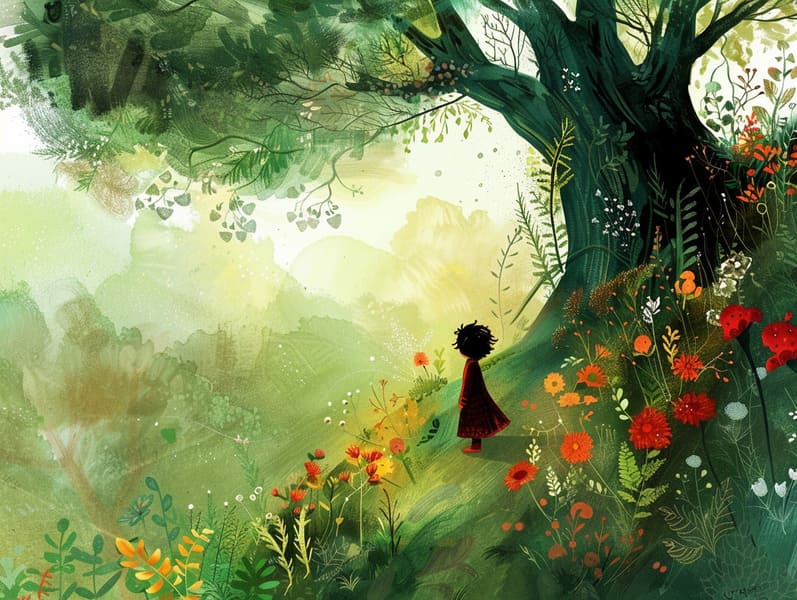The Beginning of Mythical Fairy Tales with Their Ageless Allure.

Vintage fairy tales have historical significance. These stories have been conveyed from one generation to the next ages before they were ever put on paper. They arose from a variety of backgrounds, including Asian traditions. They were initially shared among adults, often carrying themes and messages reflective of the societal norms and beliefs of the time.
The Grimm brothers, Jacob and Wilhelm (the Grimm brothers), were among the first to compile and release many of these beloved tales. Their compilation, "Grimm's Fables," included classics like "The Little Glass Slipper," "The Bread Crumb Trail," and "Snow White," which have since become pillars in the world of children's fairy tales. Similarly, H. C. Andersen's fantastical fairy tales, such as "The Mermaid," and "The Ugly Duckling," have gained the love worldwide, guaranteeing their place in the pantheon of famous fairy tales.
Despite their age, fairy tales remain as applicable as ever, especially as nighttime stories for kids. These whimsical stories are now available in diverse formats, including vibrantly illustrated books, delightful animations, and web-based fairy tales.
Their lasting presence can be connected to several charming aspects:
Ethical Lessons: Classic fairy tales often teach important moral lessons. Narratives like "The Wolf and the Liar" teach the value of sincerity, while "The Tortoise and the Hare" demonstrate the benefits of determination and humbleness. These tales offer kids clear distinctions between correct and incorrect, helping to shape their moral compass in a subtle yet meaningful way.
Warmth and Understanding: Ancient fairy tales frequently showcase beings facing challenges and problems, prompting young listeners to understand with their struggles and applaud their triumphs. For instance, "The Story of Beauty and the Beast" demonstrates the necessity of looking beyond appearances to appreciate the real person of a person, advancing awareness and discernment.
Cultural Perception: Many ancient fairy tales are deeply embedded in the cultural contexts from which they sprang. Exploring these stories can provide enlightening views into different customs, nurturing a sense of world awareness and knowledge.
Fantasy and Imagination: The enchanted elements in timeless fairy tales—enchanted objects—engender children’s creativity. These stories take readers to magical realms, invigorating fantasy ideas and a sense of magic that continues a lifetime.
Traditional fairy tales are not only entrancing but also educational. They function as bewitching tools in developing various cognitive and affective skills in kids. When old fairy tales are spoken, they promote speech development by introducing new language items and detailed these guys sentence structures. This practice also improves hearing abilities and concentration, as young readers remain attentive, anticipating to see what happens next.
Furthermore, discussing the themes and characters of ancient fairy tales can cultivate problem-solving abilities and thought processes. Little ones are led to see patterns, make predictions, and grasp cause and effect. These examinations also advance kids verbalize their thoughts and feelings, nurturing their emotional intelligence.
In today’s information age, the availability of free fairy tales online has made these stories more obtainable than ever. Internet sites and web apps present large libraries of timeless fairy tales that can be seen or listened through anytime, anywhere. Fairy tales narrated are particularly in demand, supplying an delightful method for children to experience these magical stories. Read-aloud stories and read-to-me stories move characters and settings to life, often augmented by delightful musical scores and melodies that elevate the story adventure.
The timeless appeal of ancient fairy tales lies in their ability to transform to current eras while continuing with their fundamental ideas. Contemporary versions of these fairy tales often integrate more multicultural protagonists and modern settings, making them relatable to today’s audience. However, the basic principles of courage, empathy, and truth remain unchanged, continuing to resonate with young readers of all ages.
Traditional fairy tales also offer a sense of protection and familiarity. They impart a tidy narrative with a definite beginning, middle, and end, often winding up with the conclusion of conflicts and the triumph of good over bad. This dependability can be encouraging for kids, giving a sense of sturdiness in an constantly changing world.
Timeless fairy tales continue to enchant and teach new generations, maintaining their mystique and meaningfulness in modern society. As children's night stories, they give a perfect blend of allure and teaching, facilitating moral values, empathy, and creativity. The abundance of online fairy tales and the widespread nature of fairy tales narrated warrant that these classic narratives remain attainable to new generations.
By sustaining and telling these tales, we continue to honor the rich tapestry of cultural heritage and cultural heritage. Whether you are viewing a beautifully illustrated book, experiencing a electronic library, or playing an voice book, the mystique of bedtime fairy tales is always within reach. These fairy tales point out of the undying essence of fairy tales and its ability to link us across eras and regions.
If you are delving into a vividly illustrated book, exploring a cyber library, or playing an narrated book, the fascination of old fairy tales is always within reach.
These tales illustrate of the invariable presence of fairy tales and its ability to connect us across generations and cultures, making a tie that fascinates and enlightens alike.